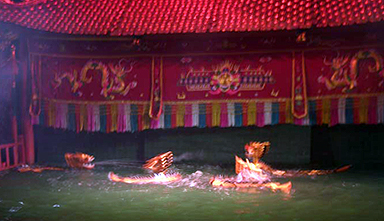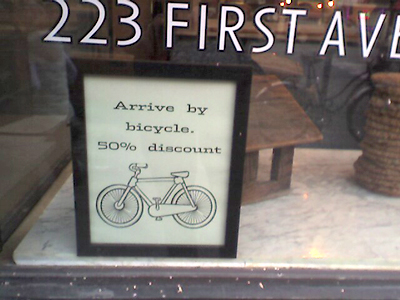October 2006
Factors
“A study reported in Science by researchers at the University of British Columbia found that women exposed to bogus scientific theories linking their gender to poor math skills performed more poorly on subsequent math tests.” More. (via)
Puppet Regime, 2

The water puppet form was invented around 1,000 years ago in the rice paddies of north Viet Nam. Once a tradition in the flooded fields, the form is now firmly folkloric, performed in the captial on a contemporary stage flooded with water. Wooden puppets are held up on bamboo poles hidden under the water and controlled from behind a curtain at the back of the stage. Our show in Hanoi consists of 12 short vignettes along with a musical prelude.
Many of the stories take place in and around the water: fantastic tales of magical fish, swimming and spitting dragons and other animal deities, moments of legendary history, and — most interesting to me — scenes mundane, every day life. Why would people living and working in the fields need to tell a story consisting of people living and working in the fields? Is it a celebration? A means of education or identification? That this is who we are, and these are our stories? Planting rice and catching fish takes place in the same narrative space, on the same stage as the emperor who returns his sword to the giant turtle in the lake, within the same frame as the dancing dragons, mating phoenix birds and other gods of nature who tease us and manipulate the world.
After the climactic, splashing dance of the four holy animals is the curtain call. The curtain rises, the players and bamboo mechanisms are revealed — it is the puppeteers who manipulate the gods.
Design Is Not Enough
Five years ago, during the week of October 22-28, 2001, a conference on social design was held at Concordia University in Montréal, Québec. The text below came out of a joint workshop there and still makes a nice manifesto that deserves wider publication.
A statement by Tony Credland, Brian Holmes, Sandy Kaltenborn on the occasion of the Decalarations Conference.
What happens to graphic design when it leaves the professional discourse behind, to do political work in activist groups and social movements? That’s the question we wanted to explore with the students and community members at Concordia University.
The answers have been different for us, and they’ll be different for everyone involved. But we know that the experience of political engagement takes design practice away from the forms in which it usually appears in society today: as advertising, art, information or propaganda.
Incentive
Seen here.
Good for You
A few data points encountered in last few months:
- Ken Roth and Colin Powell argue that the U.S. shouldn’t torture detainees because then others will torture U.S. soliders.
- In The Feminine Mystique, Betty Friedan argues that women should not be deprived of their freedom because they will live vicariously through their sons, doting on them, and turning them into sissies.
- A summer Bollywood movie stars Aishwarya Rai, a former Miss World, as a victim of domestic violence who eventually shoots dead her battering spouse. Based on a true story.
Ultimately, the arguments put forth that the abuses are not bad because they cause pain or suffering to others, but because they harm the more powerful party (with the exception of the movie which is apparently pretty grizzly). The otherness of the victims is essentially unchallenged. It’s not just that the victims are less human, but that the more powerful figure is recognized as the more valuable.
FAQ
OK, here goes. I’ve never intended this blog to be about me personally, but whenever I talk to a group of design students they often ask the same questions. This time one of them made a transcript. Many thanks to Stephanie Diederich at Virginia Commonwealth University. I’ve edited the text a little and fleshed it out in some places.
SD: How’d you get into your line of work?
JE: In the late 80’s and early 90’s I became increasingly aware of events in the news: riots in my home town, in Miami, Florida, the first Gulf War, genocides in Rwanda and the Balkans. I had a pretty privileged, middle-class background and when I went to art school in New York City in 1991, I was suddenly faced daily with poverty and homelessness. By the time I got to grad school, I was making increasingly politicized artwork. I decided that I didn’t want to make big abstract oil paintings or decorative objects for rich people. I started playing with cheap, reproducible work — multimedia, works on paper, tiny paintings to give away. My work was increasingly populist and my peers and faculty were increasingly defensive about the fact that I wasn’t “buying in.” I dropped out after a semester and decided that rather than use my politics in my art, I would use my art for my politics. I decided to become an activist designer.
Puppet Regime
 UNICEF has a brief publication online discussing puppetry as a medium for education and social change. It quotes practitioners in Indonesia, South Africa, Iran, and Hong Kong. Another twenty or so examples from around the world, primarily focusing on public health, are listed here. (via)
UNICEF has a brief publication online discussing puppetry as a medium for education and social change. It quotes practitioners in Indonesia, South Africa, Iran, and Hong Kong. Another twenty or so examples from around the world, primarily focusing on public health, are listed here. (via)
See also this brief history of radical puppetry in the U.S. and Europe.
Hundreds of Grapus Posters Online!
The city of Aubervilliers has posted images of hundreds of posters created by members of the French design collective Grapus before, during, and after their official establishment from 1970 to 1990. Grapus emerged from the Atelier Populaire in May 1968.
It’s not the easiest site to navigate — once you click on a category, the tiny page numbers appear to the right, just under the thumbnails.
Grapus was active in Aubervilliers in the 1980’s and deposited their work with the city archives — who eventually posted them online just last month. The archive is the most complete collection of their ouput, consisting of 863 posters spanning 20 years of collective work on social, cultural and political issues. (Thanks, Gilles!)


